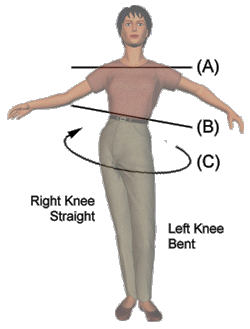Intro to Hip Motion
Hip Movement Motivated by the Knees
Why the Knees?
Latin motion is actually more than just movement of the hips...
It involves movement of the entire body, from finger tips to toes. As onlookers,
we have a tendency to notice the movement of the hips more than anything else.
But the action of one part of the body is typically the result of an action of
another, and the hips are no exception...
Latin hip motion is a result of the alternate bending and straightening action of the knees.
If you think of hip motion in this way, it becomes a much
less intimidating prospect to learn the technique. Most people are more
comfortable with and responsive to the concept of learning "knee
motion" rather than "hip motion".
The most common error with beginners learning hip motion
is their tendency to sway the entire body in one direction, rather than
isolating the hips from the spine. But when the proper knee action is
learned, then good isolated hip motion is the inevitable result.
How Does It Work?
Latin hip motion is the rotation of the hips around the spine,
caused by the alternate bending and straightening action of the knees.
When you want to create a shifting or "settling" action of the hips,
you will bend one knee while leaving the other straight.

In the diagram above, the woman is bending her left knee while leaving the right
knee straight. Notice the effect that this has on the position of her hips and body:
-
Because the left knee is bent, the left hip is lower than
the right hip. Line (B) illustrates the resulting angle at the waistline.
-
The shoulder line (A), however, is still straight. The sides of the torso
are therefore not equal; The left side is stretched long, while the right
side is shorter.
-
Line (C) shows the clockwise rotation of the hips resulting from the
straight knee and hip being pushed backwards while the bent knee
and hip push forward.
Now you should start to get an idea of how the different ranges of motion are
used by the hips. They do more than just shift slightly from side to side; They
use all of the ranges of motion. The hip over the bent knee rotates forward and
downward while the hip over the straight leg rotates up and backward.

